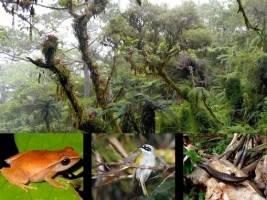|
||||||||||||||||||
|
|
Haiti - Environment : The Macaya National Park, one of the key natural sanctuaries of Haiti 24/03/2016 10:47:14
In 2013, as part of a concerted effort by the government and its partners, including UNEP, to protect and restore the park, the boundaries of the protected area were expanded from 2000 hectares to more than 8700 hectares. Pic Macaya, the highest point in the Park, reaches 2,347 meters and the surrounding area contains some the country’s last virgin cloud forest. The region is a paradise for epiphytes, including ferns, bromeliads and orchids, containing an impressive 141 varieties of orchids, 38 of which are endemic, as well as 367 other varieties of flowering plants, including 55 endemic species. Other important plant varieties include 99 species of moss and 103 varieties of ferns, three of which are endemic to the area. Additionally, Macaya Natural National Park is home to a wide variety of animal species, including two terrestrial mammal species endemic to the park. The Macaya National Park alone is home to 65 species of birds, out of a total of 230 species present in Haiti. The Park also houses 54 species of amphibians and reptiles, representing the highest endemism of amphibians in the world, especially for frogs. Some species of animals believed to be extinct, such as the "Mozart’s frog" https://www.haitilibre.com/en/news-2117-haiti-ecology-rediscovery-of-amphibians-that-have-disappeared-since-1991.html have been found in the area surrounding Pic Macaya during recent years. Macaya National Park is also an important source of freshwater. Rainfall here amounts to an average of 4000 cubic millimetres a year, supplying the seven major rivers in Haiti’s south-west peninsula with fresh water. Unfortunately, the harvesting of wood for the charcoal and construction industries, as well as burning of forest for the expansion of agricultural and pastoral land represent some of the biggest threats to the Macaya Park’s forests. This has led to the degradation of the environment, deforestation and landslides, and an accelerated erosion of the soil and the mountain ecosystem. Stimulating socio-economic development in the area is crucial for addressing these threats. Aiming to support the sound management and development of the park in the future, the Macaya National Natural Park Management Plan was adopted through the efforts of UNEP and other organizations in 2015. The Macaya Management Plan outlines specific efforts to improve the living standards of the population residing around and within the boundaries of the park, as well as to ensure the protection and regeneration of the park’s natural resources. Next steps for the government and its partners, including UNEP, the government of Norway and the IDB, include the implementation of the Macaya National Natural Park Management Plan and capacity building support to the Macaya Park Management Bureau, including priority infrastructure, equipment and the development of services, such as a Park Rangers programme, ecotourism, awareness-raising and education, conservation, and environmental analysis. See also : https://www.haitilibre.com/en/news-11333-haiti-environment-survival-of-the-macaya-park-is-both-political-and-civic.html https://www.haitilibre.com/en/news-9469-haiti-environment-visit-of-president-martelly-to-the-national-park-la-visite.html https://www.haitilibre.com/en/news-9445-haiti-politic-official-visit-of-irina-bokova-and-michaelle-jean.html https://www.haitilibre.com/en/news-9356-haiti-environment-$12mm-for-the-macaya-natural-national-park.html https://www.haitilibre.com/en/news-9136-haiti-environment-$9mm-grant-for-the-protection-of-the-macaya-national-park.html https://www.haitilibre.com/en/news-2117-haiti-ecology-rediscovery-of-amphibians-that-have-disappeared-since-1991.html HL/ HaitiLibre
|
|
|
Why HaitiLibre ? |
Contact us |
Français
Copyright © 2010 - 2024 Haitilibre.com |



